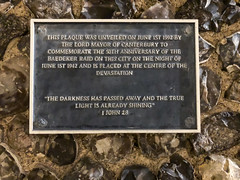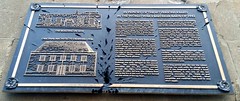Baedeker Blitz
Commemorated on 2 plaques
This plaque was unveiled on June 1st 1992 by the Lord Mayor of Canterbury to commemorate the 50th anniversary of the Baedeker Raid on this city on the night of June 1st 1942 and is placed at the centre of the devastation "The darkness has passed away and the true light is already shining" 1 John 28
Saint George's Tower, 27 St George's Street, Canterbury, United Kingdom where it sited (1942)
In memory of the 417 persons killed in the World War II Baedeker Raids of 1942. [full inscription unknown]
James Street West, Bath, United Kingdom where it sited


